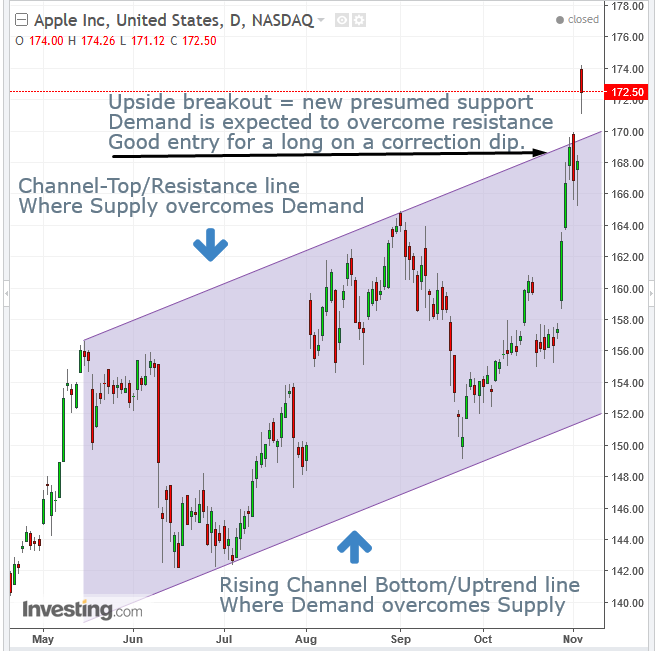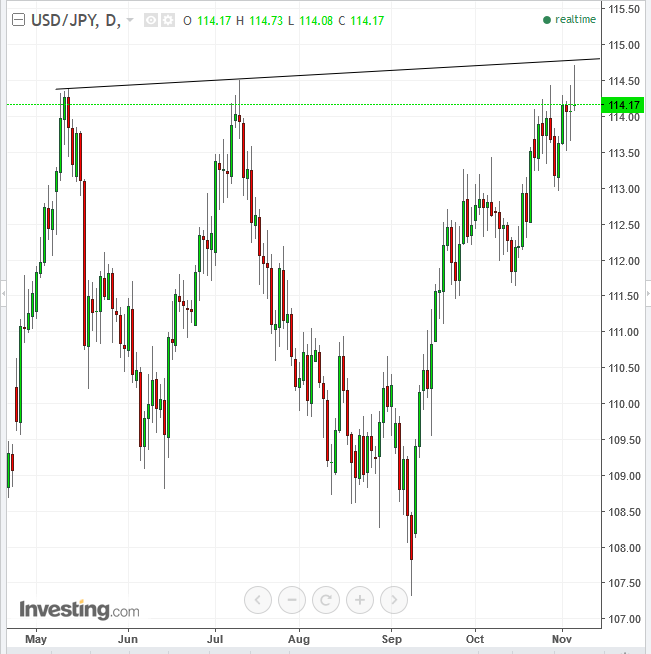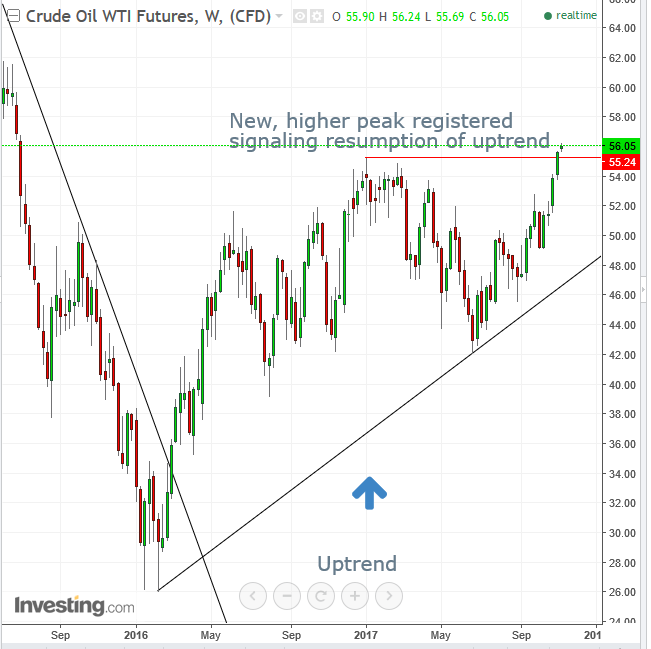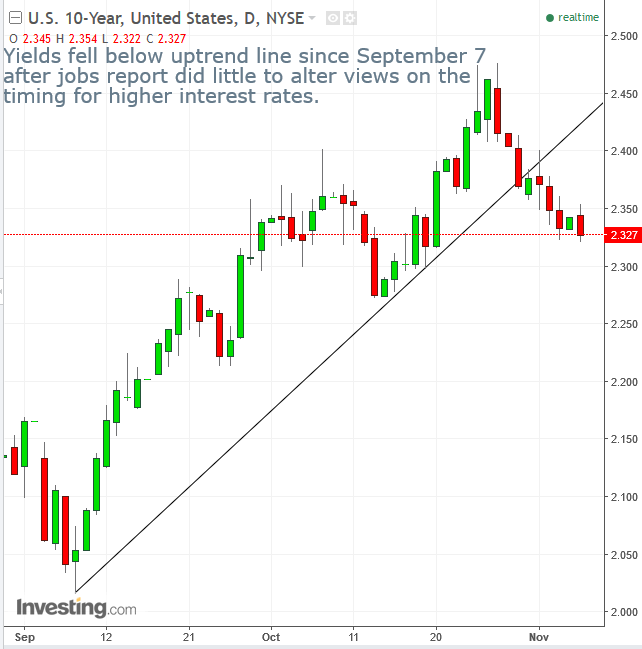by Pinchas Cohen
Key Events
Major US indices including the S&P 500, NASDAQ and NASDAQ 100 set an eighth straight weekly record on Friday, the longest string of weekly gains since 2013, as Apple (NASDAQ:AAPL) earnings and services sector data spurred additional investor optimism about the country's economy.
Apple’s results revealed its revenue growth accelerated for the fourth straight quarter, with EPS growth of 24 percent on quarterly revenues of $52.62 billion, an increase of 12 percent from the year-ago quarter, and quarterly earnings per diluted share of $2.07.

The stock has been trading within a rising channel since June. Friday’s earnings increased demand sufficiently to overcome the supply at the $170 level of the channel-top. That’s because the good earnings convinced some of the supply to convert to demand, tipping the scales of the supply-demand balance.
Once the resistance line at the channel top is broken, it is assumed to have turned to support, for the same reason some of the supply turned to demand, on the good news.
After the large 3.5 percent up gap—which occurs when everyone wants to buy at a price where there are no sellers—even after a decline pared the gain to 2.65 percent, it is ripe to “be filled.” This could happen on a dip, a downward correction, led by traders who may think that the initial spike could have been overly optimistic.
Since the channel-top is now a presumed support, this would be a good long entry point.
Global Financial Affairs
Global equity markets started the trading week muted. Asian stocks were mixed after China’s central bank chief warned again about excessive leverage and Trump, during his visit to Japan, brought up trade grievances in a press briefing.
The yen tumbled to its weakest position since March. In rare form, Japanese equities, including the TOPIX, joined the sell-off after BOJ Governor Haruhiko Kuroda said it’s crucial for inflation to exceed the 2% target, suggesting interest rate hikes or balance sheet tapering are nowhere in sight. On the face of it, the yen should sell off on its divergence from the US's path of interest rates and the resulting negative differentials.
Investment by foreigners in Japan's stocks increased by 697 billion yen during the week ending October 26, 2017. In YTD local currency terms, Japanese stocks are lagging developed markets, making shares cheaper to acquire. As well, Japan has ended its second-longest expansion since the end of WWII, even as corporate earnings are hitting yet additional record highs, with more than reasonable stock valuations of 16 times PE, relative to 20 times. For comparison, the current median S&P 500 PE ratio is 25.80.
Add to this that any uncertainty—such as the ongoing threat from North Korea or Donald Trump's aggressive stance on trade issues with Japan—along with the potential for a US tax reform disappointment, could send investors rushing headlong into parking capital in acknowledged safe havens such as the Japanese yen.

The price of the USDJPY pair has reached the top of the trading range in effect since May 9 and fallen, forming an intraday, extremely bearish Shooting Star, with a tiny real body and an extremely long upper shadow. It's a clear display that the bears are in charge.
The Stoxx Europe 600 Index fell, led by banks and telecom shares, offsetting outperforming basic resource and technology companies.
Crude oil broke through the $55 key level, after the US oil rig count dropped. Rising demand supports the global growth story.
On Friday, Baker Hughes said the number of active U.S. rigs drilling for oil fell by 8 to 729 this past week. That was the fourth weekly decline in five weeks.
Another critical impetus for the sudden demand are rising hopes this year’s OPEC production cap deal will be extended through 2018. This demonstrates a return to faith in the efficacy of the OPEC cartel, whose shine has been dimming since US shale production usurped their power to manipulate prices.
Traders are also following dramatic developments in Saudi Arabia, after an anti-corruption purge, spearheaded by Crown Prince Mohammed bin Salman and directed at dozens of princes, wealthy businessmen and government ministers, swept through the kingdom over the weekend. Observers see this as the acceleration of the crown prince's efforts to consolidate his power. Investors are seeing it as an upside risk to the oil market.
However, RBC's global head of commodity strategy Helima Croft suggested to clients that the arrests of some of the most powerful men in the kingdom were part of something bigger:
"The key question now is whether MBS has launched or preempted a new destabilizing 'Game of Thrones' by arresting his relatives in such dramatic fashion."
Croft doesn’t think the dramatic arrests are over. Private air strips in the kingdom remain closed and the national guard is keeping the population in line as clerics lead protests. Historically, unrest is seen as a potential disruption to oil output, causing crude prices to rise.
Ironically, these protests are in line with the interests of the kingdom. In order to break even on oil production, Saudi Arabia needs to sell oil at $70 a barrel according to the IMF.

On Thursday, the price of oil reached $55.76. The surge was extended on Friday to an intraday high of $56.24, registering a second-day peak higher than the former, at $55.24 on January 2, completing the second peak needed to complete a viable midterm uptrend line.
Additionally, the price has risen 33 percent since the previous low of $42.05 on June 19, more than the required 20 percent rise necessary to call this a bull market, in which upswings are presumed to be part of the trend, while downswings are considered corrections.
Up Ahead
- The European Commission’s chief Brexit negotiator Michel Barnier and UK Brexit Secretary David Davis resume talks on the terms of Britain’s exit from the European Union.
- Earnings season continues with reports from Toyota (NYSE:TM), Disney (NYSE:DIS), Adidas (OTC:ADDYY) and Siemens (OTC:SIEGY). European financial companies set to report include Intesa Sanpaolo (MI:ISP), Banca Monte dei Paschi di Siena SpA (MI:BMPS), Credit Agricole (PA:CAGR), Allianz (DE:ALVG) and Zurich Insurance Group (SIX:ZURN).
- Donald Trump continues his first official trip to Asia as President, accompanied by Secretary of State Rex Tillerson and a group of U.S. business leaders. On Tuesday he heads to South Korea.
- Also on Tuesday, New Jersey and Virginia will choose new governors in off-year elections.
- U.S. consumer sentiment probably cooled in early November from a more than 13-year high; the University of Michigan’s report is out on Friday.
- OPEC releases its World Oil Outlook, presented by Secretary-General Mohammad Barkindo.
- Argentina, Australia, Mexico, New Zealand, Peru, Malaysia, Poland, Serbia and Thailand all set monetary policy.
Market Moves
Stocks
- The Stoxx Europe 600 Index fell less than 0.05 percent as of 8:17 London time (3:17 EDT).
- The U.K.’s FTSE 100 increased less than 0.05 percent to the highest on record.
- Germany’s DAX fell 0.1 percent.
- Japan’s Nikkei 225 gained less than 0.05 percent, its highest point in more than 21 years.
- The MSCI Asia Pacific Index decreased 0.1 percent.
- The MSCI Emerging Markets Index increased 0.1 percent.
- S&P 500 Futures sank 0.1 percent to 2,580.50.
Currencies
- The Dollar Index gained 0.7 percent, after falling 0.6 percent.
- The euro rose less than 0.05 percent to $1.1611.
- The British pound was unchanged at $1.3077.
- The Japanese yen decreased 0.2 percent to 114.27 per dollar, the weakest in six months.
Bonds

- The yield on 10-year Treasuries dipped one basis point to 2.32 percent, the lowest in more than two weeks.
- Germany’s 10-year yield fell two basis points to 0.34 percent, the lowest in eight weeks.
- Britain’s 10-year yield declined two basis points to 1.245 percent, the lowest in more than seven weeks.
- Japan’s 10-year yield decreased three basis points to 0.025 percent, the lowest in almost eight weeks.
Commodities
